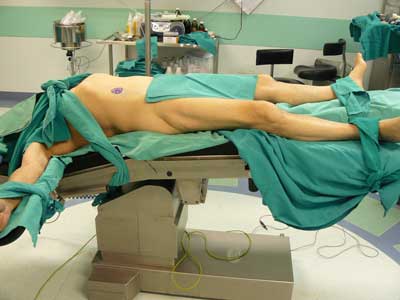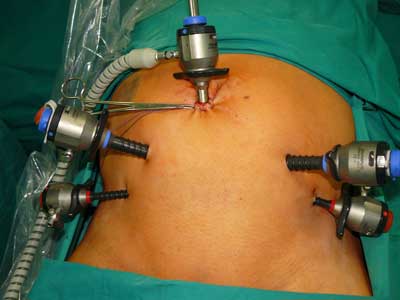© Borgis - Postępy Nauk Medycznych 4/2012, s. 320-324
*Piotr L. Chłosta1, 2, 3, 5, Tomasz Drewa3, 4, Paweł Olejniczak3, Jakub Dobruch1, 2, Mateusz Obarzanowski3, Łukasz Nyk2, Michał Andrzej Skrzypczyk2, Andrzej Borówka1, 2, 3
Radykalne wycięcie pęcherza moczowego metodą laparoskopii: ocena wyników pooperacyjnych i patologicznych
Laparoscopic radical cystectomy: operative and pathologic outcomes
1Department of Urology, Medical Centre of Postgraduate Education Warsaw
Head of the Dept.: Prof. Andrzej Borówka, MD, PhD
2Department of Urology, European Health Centre Otwock
Head of the Dept.: Prof. Andrzej Borówka, MD, PhD
3Department of Urology, Holy Cross Cancer Centre Kielce
Head of the Dept.: Prof. Piotr L. Chlosta, MD, PhD
4Department of Tissue Engeneering Collegium Medicum Nicolaus Copernicus University, Bydgoszcz
Head of the Dept.: Prof. Tomasz Drewa, MD, PhD
5Department of Health Science, Jan Kochanowski University, Kielce
Streszczenie
Wstęp. Klasycznym sposobem chirurgicznego leczenia raka naciekającego błonę mięśniową pęcherza moczowego jest otwarta cystektomia radykalna (RC). Po wycięciu pęcherza wytwarza się nadpęcherzowe odprowadzenie moczu lub rekonstruuje sie pęcherz z izolowanego fragmentu jelita. W ostatnim czasie, w celu zmniejszenia inwazyjności RC, zaproponowano wykonywanie tej operacji metodą laparoskopową (LRC). Doświadczenie światowe dotyczące LRC nie jest jeszcze duże, niemniej liczba zwolenników tej operacji stopniowo zwiększa się.
Cel pracy. Dokonanie analizy własnych doświadczeń, dotyczących LCR oraz oceny jej skuteczności i bezpieczeństwa.
Materiał i metody. LRC w okresie od lutego 2006 r. do czerwca 2008 r. wykonano u 22 chorych (21 mężczyzn i jednej kobiety) na miejscowo zaawansowanego raka pęcherza moczowego (cT2-3N0M0).
Wyniki. Operację przeprowadzono w całości metodą laparoskopową u 21 chorych. U jednego chorego, wobec trudności technicznych uniemożliwiających kontynuowanie operacji w technice endoskopowej, dokończono ją w sposób klasyczny (konwersja). Średni czas LRC wynosił 290 min (270-340 min). Średnia utrata krwi w czasie LRC wynosiła 220 ml (190-550 ml). Średnia liczba usuniętych węzłów chłonnych wynosiła 17 (15-25). U trzech chorych stwierdzono przerzuty w regionalnych węzłach chłonnych. Przebieg pooperacyjny nie był powikłany. Średni czas pobytu chorych w szpitalu po operacji wyniósł 8 dni (5-18 dni).
Wnioski. LRC jest operacją trudną technicznie, jednak stwarza możliwość usunięcia pęcherza dotkniętego rakiem zgodnie z zasadami radykalnej chirurgii uro-onkologicznej i u niektórych chorych pozwala na wytworzenie nadpęcherzowego odprowadzenia moczu bez konieczności wykonywania rozleglej laparotomii. Inwazyjność LRC jest wyraźnie mniejsza od inwazyjności RC otwartej.
Summary
Introduction and Objectives. The standard management in invasive bladder cancer patients is radical cystectomy (RC). After cystectomy urinary diversion is often based on conduit or ileal neobladder. Last decade to minimize invasiveness of RC, laparoscopic radical cystectomy was proposed. Wordwide experience in LRC is not high, neverless the nuber of this procedure increases in time.
We report our experience with lLRC evaluating efficacy and safety.
Material and methods. From February 2006 to June 2008 we performed 22 LCRs in the 22 consecuitive cases of locally advanced bladder cancer (cT2-3N0M0).
Results. In 21 patients the procedure was preformed laparoscopically. In one case, because of technical difficulties, conversion to standard, open technique was necessary. The mean time of the surgery was 290 min (270-340 min). The mean blood loss during LCR was 220 mL (from 190 to 550 mL). Blood transfusion was necessary in two cases of LCR. Mean number of removal lymph nodes was 17 (15-25). Three patients (13.5%) had active tumor in the resected lymph nodes. The postoperative course was uncomplicated. Mean hospital stay was 8 days (5-18 days)
Conclusions. LCR is technically advanced surgical procedure in the management of invasive bladder cancer. LRC offers complete bladder removal based on oncological criteria in well selected patients and in some of them to create urinary diversion without widespread laparotomy. LRC is less invasive procedure than standard open RC.

Introduction
Radical cystectomy (RC) ist the treatment of choice in both muscle invasive and locally advanced bladder cancer, and for selected patients in non-muscle invasive bladder cancer with highr risk of progression (1, 2).
RC is based on urinary bladder removal in conjunction with the prostate and seminal vesicles in male patients, while urethra and anterior vaginal wall in females.
Integral part of RC in both sexes is regional pelvic lymph node dissection (PLND). After urinary bladder excision urinary diversion is created during the same surgery. It is usually made by ileal conduit or by orthotopic intestinal neobladder reconstruction.
Oncological efficacy is related of pathological stage of disease (T) and regional lymph node invasion (N) (3). The most important criteria is cancer specific survival (CSS) Cafter surgery.
The large series data indicates 5 and 10 years CSS 65-80% and 40-60% respectively after RC (4-6).
In uro-oncology leading centers of excellence, with the biggest experience of laparoscopic urological surgery, the laparoscopic techniques was successfully development to perform RC. They created the fundamental principles to perform both laparoscopic radical cystectomy (LRC) and robot – assisted radical cystectomy (RALRC) in male and female patients (7-10).
Based on our experience with comparison the early results of another centres, we started LRC in Holy Cross Cancer Centre in 2006 (11). Since that time we developed the this technique, and now we perform LRC routinely in properly selected patients, especially those with no – contraindications to laparoscopic surgery.
Objective
Aim of this study is to analize our experience in LCR and its short term safety and efficacy.
Matherial and methods
From February 2006 to June 2008 we performed 22 LCRs (21 males and one female) in the 22 consecuitive cases of locally advanced bladder cancer with no clinically lumph nodes involvement (cT2-3N0M0) (tab. 1). Mean patients age was 65,4 yrs (from 55 to 72 yrs).
Laparoscopic radical cystectomy was performed in following steps. Patients positioning in operation table was in Trendelenburg position (fig. 1). During surgery 5 trocars were used (both three 10 mm and two 5 mm trocars) (fig 2). In males, surgery was started from perineal incision between rectum and bladder, than vasa and seminal vesicles were divided together with posterior prostate surface. After that, proximal part of both ureters was controlled and cut off from the bladder. Anterior surface of the prostate was exsposed in the third part of LCR, and lateral bladder ligaments were controlled hemostaticly; endopelic fascia was sharply divided from the lateral pelvic walls, and dorsal vein complex was ligated and divided. Than the specimen was removed in silicon laparoscopic bag after his cut off from urethra, via minilaparotomy way (fig. 3). In selected patiennts minilparotomy approach was susscesfully used to create urinary diversion.

Fig. 1. Patient positioning for laparoscopic radical cystectomy.

Fig. 2. Trocars placement for laparoscopic radical cystectomy.

Fig. 3. Specimen removal via minilaparotomy way.
Table 1. Pathological stage (pT) of the bladder cancer and lymph nodes status in LRC patients.
| pT | Number/percentage patients | Lymph nodes involvement (N+) |
| pT2b | 9 (41,5%) | 0 |
| pT3a | 10 (45%) | 0 |
| pT3b | 3 (13,5%) | 3 (13,5%) |
Powyżej zamieściliśmy fragment artykułu, do którego możesz uzyskać pełny dostęp.
Mam kod dostępu
- Aby uzyskać płatny dostęp do pełnej treści powyższego artykułu albo wszystkich artykułów (w zależności od wybranej opcji), należy wprowadzić kod.
- Wprowadzając kod, akceptują Państwo treść Regulaminu oraz potwierdzają zapoznanie się z nim.
- Aby kupić kod proszę skorzystać z jednej z poniższych opcji.
Opcja #1
29 zł
Wybieram
- dostęp do tego artykułu
- dostęp na 7 dni
uzyskany kod musi być wprowadzony na stronie artykułu, do którego został wykupiony
Opcja #2
69 zł
Wybieram
- dostęp do tego i pozostałych ponad 7000 artykułów
- dostęp na 30 dni
- najpopularniejsza opcja
Opcja #3
129 zł
Wybieram
- dostęp do tego i pozostałych ponad 7000 artykułów
- dostęp na 90 dni
- oszczędzasz 78 zł
Piśmiennictwo
1. Babjuk M, Oosterlink W, Sylvester R et al.: Guidelines on TaT1 (non muscle invasive) bladder cancer: European Association of Urology Guidelines 2008. EAU 2008; 1-22.
2. Stenzl A, Cowan NC, De Santis M et al.: Guidelines on muscle invasive and metastatic bladder cancer: European Association of Urology Guidelines 2008. EAU 2008; 1-59.
3. Bassi P, Ferrante GD, Piazza N et al.: Prognostic factors of outcome after radical cystectomy for bladder cancer: a retrospective study of homogenous patient cohort. J Urol 1999; 161: 1494-7.
4. Stein JP, Lieskovsky G, Cote R et al.: Radical cystectomy in the treatment of invasive bladder cancer: long-term results in 1.054 ptients. J Clin Oncol 2001; 19: 666-75.
5. Gschwend JE, Dahm P, Fair WR: Disease specific survival as endpoint of outcome for bladder cancer patients following radical cystectomy. Eur Urol 2002; 41: 440-8.
6. Shariat SF, Karakiewicz PI, Palapattu GS et al.: Outcomes of radical cystectomy for transitional cell carcinoma of the bladder: a contemporary series from Bladder Cancer Research Consortium. J Urol 2006; 176: 2414-22.
7. Cathelineau X, Arroyo C, Rozet F et al.: Laparoscopic assisted radical cystectomy: the Montsouris experience after 84 cases. Eur Urol 2005; 47: 780-4.
8. Haber GP, Campbell SC, Colombo Jr JR et al.: Perioperative outcomes with laparoscopic radical cystectomy: ‘‘pure laparoscopic’’ and ‘‘open-assisted laparoscopic’’ approaches. Urology 2007; 70: 910-5.
9. Haber G-P, Gill IS: Laparoscopic radical cystectomy for cancer: oncological outcomes at up to 5 years. BJU Int 2007; 100: 137-42.
10. Wang GJ, Barocas DA, Raman JD et al.: Robotic vs. open radical cystectomy: prospective comparison of perio-perative outcomes and pathological measures of early oncological efficacy. BJU Int 2008; 101: 89-93.
11. Chłosta P, Antoniewicz AA, Jaskulski J et al.: Technika radykalnego wycięcia pęcherza moczowego metodą laparoskopową: Urol Pol 2008; 61, Supl. 1: 37-38.
12. Wang GJ, Barocas DA, Raman JD et al.: Robotic vs. open radical cystectomy: prospective comparison of perio-perative outcomes and pathological measures of early oncological efficacy. BJU Int 2008; 101: 89-93.
13. Hautmann RE: The oncologic results of laparoscopic radical cystectomy are not (yet) equivalent to open cystectomy. Curr Opin Urol 2009; 19: 522-6.
14. Schumacher MC, Jonsson MN, Wiklund NP: Does extended lymphadenectomy preclude laparoscopic or robot-assisted radical cystectomy in advanced bladder cancer? Curr Opin Urol 2009; 19: 527-32.
15. Chade DC, Laudone VP, Bochner BH et al.: Oncological outcomes after radical cystectomy for bladder cancer: open versus minimally invasive approaches. J Urol 2010; 183: 862-69.
16. Kasraeian A, Barret E, Cathelineau X et al.: Robot-assisted laparoscopic cystoprostatectomy with extended pelvic lymphadenectomy, extracorporeal enterocystoplasty, and intracorporeal enterourethral anastomosis: initial Montsouris experience. J Endourol 2010; 24(3): 409-13.
17. Ng CK, Kauffman EC, Lee MM et al.: A comparison of postoperative complications in open versus robotic cystectomy. Eur Urol 2010; 57: 274-81.
18. Haber G-P, Gill IS: Laparoscopic radical cystectomy for cancer: oncological outcomes at up to 5 years. BJU Int 2007; 100: 137-42.
19. HaberGP,CampbellSC,Colombo Jr JR et al.: Perioperative outcomes with laparoscopic radical cystectomy: ‘‘pure laparoscopic’’ and ‘‘open-assisted laparoscopic’’ approaches. Urology 2007; 70: 910–5.
20. Huang J, Lin T, Liu H et al.: Laparoscopic radical cystectomy with orthotopic ileal neobladder for bladder cancer: oncologic results of 171 cases with a median 3-year follow-up. Eur Urol 2010; 58: 442–9.
21. Chade DC, Laudone VP, Bochner BH et al.: Oncological out- comes after radical cystectomy for bladder cancer: open versus minimally invasive approaches. J Urol 2010; 183: 862-9.
22. Kauffman EC, Ng CK, Lee MM et al.: Early oncological outcomes for bladder urothelial carcinoma patients treated with robotic-assisted radical cystectomy. BJU Int 2011; 107: 628-35.
23. Wang GJ, Barocas DA, Raman JD et al.: Robotic vs open radical cystectomy: prospective comparison of peri-operative outcomes and pathological measures of early oncological efficacy. BJU Int 2008; 101: 89-93.
24. Cathelineau X, Arroyo C, Rozet F et al.: Laparoscopic assisted radical cystectomy: the Montsouris experience after 84 cases. Eur Urol 2005; 47: 780-4.



